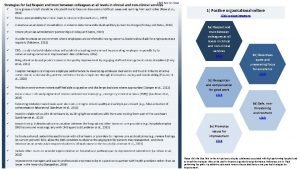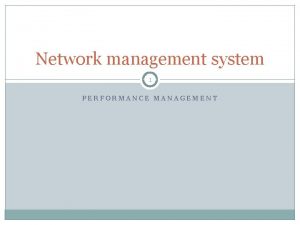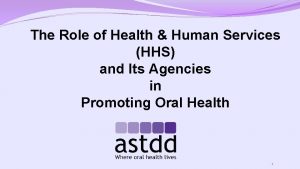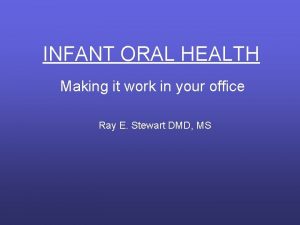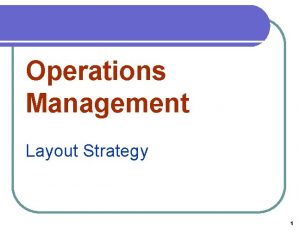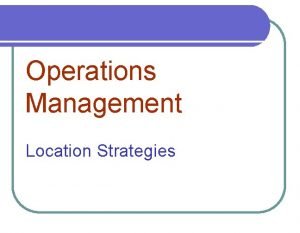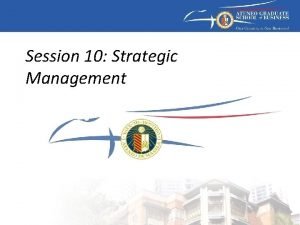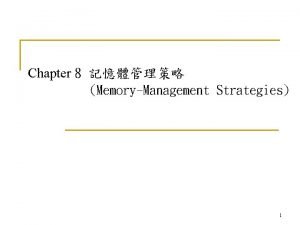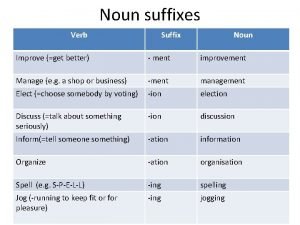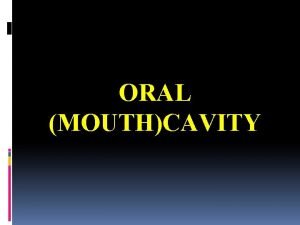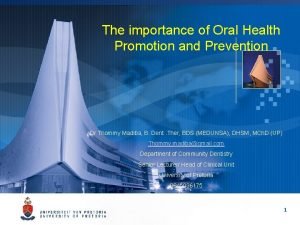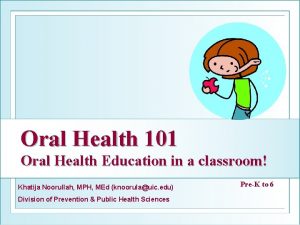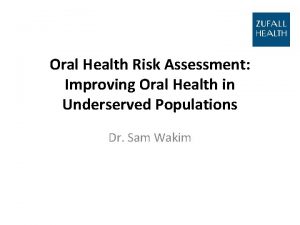Adopting Performance Management Strategies to Improve Oral Health































































- Slides: 63

“Adopting Performance Management Strategies to Improve Oral Health in Your State” April 12, 2017 1

General Reminders • This webinar will be recorded and archived on the ASTDD website • We would like to hold any questions until the end, so if you have questions, please make a note of them. When we are ready for questions, if you wish to ask one, please click on the Set Status icon which is the little man with his arm raised on either the upper left or the top of your screen. Click on “raise hand. ” We will then call on you to ask your question over the phone • Please respond to the polling questions at the conclusion of the webinar 2

Funding Acknowledgement(s) • This presentation was supported by Cooperative Agreement NU 58 DP 004919 -05 -00 from the CDC, Division of Oral Health and by the Health Resources and Services Administration (HRSA) of the U. S. Department of Health and Human Services (DHHS) under grant #H 47 MC 00048. This information or content and conclusions are those of the authors and should not be considered as the official position or policy of the CDC, HRSA, DHHS, or the U. S. government, nor should any endorsements be inferred. 3

Moderator /Presenters • Harry Goodman, DMD, MPH • Ellen Volpe, MHA • Mary Davis, Dr. PH, MSPH • Erin Knoerl, MPH • Katy Battani, RDH, MS 4

Learning Objectives At the end of this webinar, participants will be able to: 1. Explain how Performance Management and Quality Improvement can be used in state oral health programs. 2. Discuss examples of use of Performance Management and Quality Improvement in state oral health programs. 3. Identify resources for further information about Performance Management and Quality Improvement. 5

Title V National Performance Measure 13 Thirty-one states and jurisdictions selected NPM 13 A: Percent of women who had a dental visit during pregnancy. NPM 13 B: Percent of children, ages 1 through 17, who had a preventive dental visit in the past year. On July 15 of each year, states and jurisdictions are required to submit an application/annual report. As part of this annual application, a state may refine its action plan. States may add new or revise existing program strategies, evidence-based or -informed strategy measures. 6

Title V National Performance Measure 13 Division of State and Community Health Title V Block Grant National Performance Measure 13 Liaisons Gor Yee Lum, M. P. H. Regional MCH Consultant NPM 13 Liaison-lead Phone: (415) 437 -8497 E-mail: Glum@hrsa. gov Cherri Pruitt, M. P. A. Regional MCH Consultant NPM 13 Liaison Co-lead Phone: (303) 844 -7872 E-mail: CPruitt@hrsa. gov 7

PERFORMANCE MANAGEMENT PRIMER 8

Let’s Start with Definitions “Performance management is the practice of actively using performance data to improve the public's health. This practice involves the strategic use of performance measures and standards to establish performance targets and goals. ”* A systematic process by which an organization involves its employees in improving the effectiveness of the organization and achieving the organization’s mission and strategic goals. *From Silos to Systems: Using Performance Management to Improve Public Health Systems – prepared by the Public Health Foundation for the Performance Management National Excellence Collaborative, 2003 9

What Can Performance Management Do for Public Health? • By improving performance and quality, public health systems can save lives, cut costs, and get better results. • Enables health departments to be more: • Efficient • Effective • Transparent • Accountable 10

Performance Management Can Result in: • Better return on dollars invested in health • Greater accountability for funding and increases in the public’s trust • Reduced duplication of efforts • Better understanding of public health accomplishments and priorities among employees, partners, and the public • Increased sense of cooperation and teamwork • Increased emphasis on quality, rather than quantity • Improved problem-solving 11

What Are Performance Management Practices? • Goal setting • Financial planning • Operational planning • Data collection • Consolidation of data • Data analysis • Reporting of data • Quality improvement • Evaluation of results • Monitoring of key performance indicators • Others? ? ? 12

Developed in 2013, adapted from the 2003 Turning Point Performance Management System Framework www. phf. org 13

Poll Have you seen the Performance Management Framework before? Yes No Not Sure 14

Visible Leadership • Engage leadership in performance management • Align performance management with organizational priorities • Track and incentivize progress Think about: • Does senior management take a visible role in performance management? • Is performance management emphasized as a priority and goal for your work? 15

Visible Leadership Senior management commitment to a culture of quality that: • Aligns performance management practices with the organizational mission • Regularly takes into account customer feedback • Enables transparency about performance against targets between leadership and staff. • Key Resource: NACCHO Roadmap to a Culture of Quality Improvement. http: //qiroadmap. org/ 16

Leadership : Bob Russell, DDS • Public Health Dental Director, IA Department of Public Health • Increased state and federal fiscal allocations toward dental public health, $3 million over 3 years • Oral Health Bureau created IA Oral Health Strategic Plan 20162020 • Initiated advocacy plan for “I-Smile” 17

18

Performance Standards • • Identify relevant standards Select indicators Set goals and targets Communicate expectations Think about: • Do you set or use standards, targets or goals for your organization or program? • How do you communicate the expectations and strategic direction for your organization or program? 19

Performance Standards • Standards may be set based on national, state or scientific organizations, by benchmarking against similar organizations, or by other methods. • Example: Healthy People 2020* OH-1: Reduce the proportion of children and adolescents who have dental caries experience in their primary or permanent teeth. *www. Healthly. People. gov 20

Performance Measurement • Refine indicators and define measures • Develop data systems • Collect data Think about: • How do you measure capacity, process or outcomes? • What tools exist to support the efforts? 21

Performance Measurement • Sets criteria and establishes scope (programmatic vs. state) • HP 2020 OH-1. 1: Reduce the proportion of children aged 35 years with dental caries experience in their primary teeth. • • • Baseline 33% Target: 30% Target Setting Method: 10% Improvement Data Sources National Health and Nutrition Survey, CDC/NCHS Timeframe: Every 3 years (example) 22

How New Hampshire Uses Criteria to Select Measures • Data should be available for several years to show trends. • Data should be reliable, in that we are confident in the accuracy of the data and that it measures what is intended to measure. • The measures should reflect new and growing initiatives. • The measures should be a good indicator of whether or not a program or intervention is working. Source: Improving the Public’s Health in New Hampshire, 2005. http: //www. dhhs. nh. gov/dphs/iphnh/documents/report. pdf 23

Reporting Progress • Analyze and interpret data • Report results broadly • Develop a regular reporting cycle Think about: • Do you document or report your unit / program’s progress? • Is this information regularly available? To whom? • What is the frequency of analysis and reporting? 24

Reporting Progress Tracking and reporting progress depends on: • Purpose of performance management system • Intended users of performance data A robust reporting system • Makes comparisons to national, state, or local standards or benchmarks • Show where gaps may exist within the system • Facilitates identifying areas for improvement 25

Reporting: SC Strategic Plan 26

Quality Improvement • Use data for decisions to improve policies, programs and outcomes • Manage changes • Create a learning organization Think about: • Do you have a quality improvement process? • What do you do with information gathered through reports? • Do you have the capacity to take action for improvement when needed? 27

Quality Improvement (QI) is the establishment of a program or process to manage change and achieve quality improvement in public health policies, programs, or infrastructure based on performance standards, measures, and reports. Most Commonly Used Tools Brainstorming, Flow Chart, SIPOC+CM, Cause and Effect Diagram, Five Whys, Solution and Effect Diagram, Check Sheets, Pareto Charts, Pie Charts, Run Charts, Control Chart, Force Field Analysis, Nominal Group Technique 28

29

Polling Have you heard of the Public Health Accreditation Board? Yes No Not Sure Is your state PHAB Accredited? Yes No Don’t Know 30

PHAB: Driving Public Health Performance PHAB Standard 9. 1: Use a performance management system to monitor achievement of organizational objectives. * For the health department to most effectively and efficiently improve the health of the population, it is important to monitor the performance of public health processes, programs, interventions, and other activities. A fully functioning performance management system that is completely integrated into health department daily practice at all levels includes: 1) setting organizational objectives across all levels of the department, 2) identifying indicators to measure progress toward achieving objectives on a regular basis, 3) identifying responsibility for monitoring progress and reporting, 4) identifying areas where achieving objectives requires focused quality improvement processes, 5) visible leadership for ongoing performance management. Department information systems and public health data support performance management. S *www. phaboard. org 31

PHAB Status Update: April 2017 Distribution of Health Departments Accredited In Process Total in e-PHAB Local 155 131 286 State 22 16 38 Tribal 1 3 4 Centralized States Integrated System* 1/67 — 1/67 Multi-Jurisdictional — 8 Total Number of Health Departments 178 + 1 system 158 337 Population (Unduplicated) 178, 255, 529 80, 819, 504 259, 075, 033 32

Putting it All Together: CT Performance Management System 33

34

Community Water Fluoridation. Performance Management Initiative Erin C. Knoerl, MPH Public Health Specialist – Community Water Fluoridation and Oral Health Workforce New York State Department of Health, Bureau of Child Health February 20, 2021

February 20, 2021 36 Community Water Fluoridation (CWF) Across NYS Population served: 13 million Fluoride adjusted water systems: 122 of 2, 407 systems Percentage of people on public water in NYS who receive optimally fluoridated water: • With NYC- 71. 7% • Without NYC- 47. 0% 36

February 20, 2021 37 Performance Management is a Priority in NYS • 2012 Strategic Plan – – • Center for Community Health Initiative – – • 2013 – current Quarterly update meetings 2016 Governor’s Office Initiative – – – • Mission Vision Strategic Map Key priority: Become a model performance-based organization Remodeled Agency Strategic Plan Annual performance plans Lean process improvement plans Update to the Strategic Map – Cross-cutting strategic priority: Use performancebased decision making in quality improvement 2016 New York State Department of Health Strategic Map as of November 17, 2016 37

February 20, 2021 38 Fluoridation is a Priority in NYS • 2016 -2020 Title V Maternal and Child Health Services Block Grant State Action Plan – Objective LC-4: Increase the percentage of NYS residents served by community water systems that have optimally fluoridated water by 10% to 78. 5%. • Prevention Agenda 2013 -2018: New York State's Health Improvement Plan – Objective 5 -4: By December 31, 2018, increase the percentage of NYS population receiving fluoridated water by 10%. (Promoting Healthy Women, Infants and Children Action Plan) – Objective 1 a: Increase the percentage of NYS residents served by community water systems that receive optimally fluoridated water by 10% from 71. 4% (2012) to 78. 5%. (Promote a Healthy and Safe Environment Action Plan, Focus Area #2) • 2014 New York State Oral Health Plan – Objective 2. a: By 2017, increase the percentage of NYS population receiving fluoridated water by 10 percent. 38

February 20, 2021 39 NYS’s CWF Program • Four programmatic focus areas • Performance management focus area: Surveillance • Program activities are accomplished through: – Department of Health (DOH) staff and – External contractors, partners and stakeholders Yellow highlighted text shows the gaps being filled through a public-private partnership 39

February 20, 2021 40 Central Goal & Challenges Year 1 Goal: Increase the percentage of NYS residents served by community water systems that receive optimally fluoridated water by 10% from 71% to 72% in 2017. Challenge: In order to maintain existing fluoridating communities we (DOH) need to: 1. 2. Be able to identify public water systems (PWS) experiencing issues with CWF operation and equipment Provide technical and financial assistance to these PWS Areas to Address: 1. 2. Consistent and timely access to CWF operation data from PWSs. Consistent delivery of optimally fluoridated water from PWSs to residents. 40

February 20, 2021 Model for Improvement • What are we trying to accomplish? • How will we know that a change is an improvement? • What change can we make that will result in improvement? 41 PDSA Cycle Act • What changes are to be made? • Next cycle? Change Idea Plan • Questions and predictions (why) • Plan to carry out the cycle (who, what, where, when) Study Do • Complete the analysis of the data • Compare data to predictions • Summarize what was learned • Carry out the plan • Document problems and unexpected observations • Begin analysis of data 41

February 20, 2021 42 Performance Measure 1 A: Percentage of NYS fluoride adjusted public water systems (PWS) that consistently submit monthly fluoride operating reports (MOR) to the NYSDOH • Operational Definition: – Numerator: # of fluoride adjusted PWS that have a MOR on file at the BCH – Denominator: # of fluoride adjusted PWS • Source: MORs and WFRS • Technical Notes: Consistently for Quarter- PWS must have all three MORs on file at BCH for a given quarter. Quarters are defined as the following: Q 1 - January-March; Q 2 - April-June; Q 3 - July-September; and Q 4 October-December. 42

February 20, 2021 43 Performance Measure 1 A • Baseline: 85. 4% of fluoride adjusted PWS have all 12 MORs on file at the NYSDOH for 2015 • Target for Improvement: 100% of fluoride adjusted PWS will have all 12 MORs on file at the NYSDOH by April 2017. This is a 17% improvement from baseline. 43

February 20, 2021 44 Internal Performance Management Process/Workflow • Track dates MORs are received in Excel – by Local Health Department/District Field Office – by the Bureau of Child Health (BCH) • Crosscheck against Water Fluoridation Reporting System (WFRS) – Reports (Operational and Average Fluoride Levels by Month) – “Fluoride Data” section • Verify missing MOR list with BWSP • Brief Bureau, Division and Center leadership on progress • Work with BWSP to implement tests of change to address measures 44

February 20, 2021 45 Percent of Fluoride Adjusted PWS with MORs on File by Quarter 100% 90% 6. 5% 2. 4% 6. 5% 8. 1% 6. 5% 5. 7% 6. 5% 0. 8% 8. 1% 10. 6% 5. 7% 13. 0% 83. 7% 81. 3% 76. 4% 2016 - Q 1 2016 -Q 2 2016 -Q 3 2016 -Q 4 80% 5. 7% 15. 4% 8. 1% 70% 60% 50% 40% 93. 5% 85. 4% 87. 8% 92. 7% 2015 - Q 2 2015 - Q 3 2015 - Q 4 30% 20% 10% 0% 2015 - Q 1 Complete (3 MORs Submitted) Semi-Complete (1 -2 MORs Submitted) Incomplete (0 MORs Submitted) 45

February 20, 2021 46 Percent of Fluoride Adjusted PWS with MORs on File for 2016 80% 73. 2% 70% 60% 50% 40% 30% 18. 7% 20% 10% 8. 1% 0% MORs Submitted 0 Months 1 -11 Months 12 months 46

February 20, 2021 The PDSA Cycle Approach to Address Missing MORs in 10 PWSs Missing full 2016 Dataset 47 Act • If successful, use another REHD call to target additional PWSs with delinquent reports from 2016 • If not successful, modify approach to conduct individual outreach to REHD or targeted District Offices instead Study • Track MORs received by BCH/BWSP from the 10 targeted PWSs • Compare data to predictions • Summarize what was learned Plan • Test of Change – alert Regional Environmental Health Directors (REHD) of the 10 PWSs with no 2016 MORs on file • Who- BWSP • What- Notify and ask for potential barriers • Where- REHD bi-weekly call • When- April 2017 • Predictions- REHD will state they will follow-up with applicable LHDs Do • Carry out the plan – BWSP holds the call • Problems, unexpected observations and feedback shared on the call by REHDs is documented by BWSP and shared with BCH • BWSP and BCH discuss internal feedback and observations 47

Perinatal and Infant Oral Health Quality Improvement Program PIOHQI Katy Battani, RDH, MS MD Office of Oral Health Department of Health and Mental Hygiene

Quick Overview of PIOHQI • • MD is one of 16 states nationwide with a PIOHQI grant HRSA-funded program via the Maternal and Child Health Bureau Strong focus on quality improvement methodology Long-term outcome: – Pregnant Women: By September 2019, increase by 15% over MD baseline the percent of women who have received prophylaxis, during pregnancy, as measured by the PRAMS data. • Three targeted aims that focus on: – Outreach: *Home visiting; social marketing campaign – Policy: Adult Medicaid dental benefit; dental hygiene curriculum – Access and Utilization: Community Health Center oral health screening pilots prior to first prenatal visits

Integration of Oral Health into Home Visits for Pregnant Women Components: • Provide training, both initial and ongoing • Collect oral health data • Provide resources and support to program

51

52

Quality Improvement Tools • Before Action Reviews/After Action Reviews (BAR/AAR) – BAR: Helps enter into an event with a common understanding of the outcomes you’re seeking and potential pitfalls – AAR: Helps capture what was learned from an event; provides opportunity to reflect and analyze; captures ideas to sustain or to improve upon • Process Mapping – Visual picture of the sequence of steps in a process; helps to fully “think through” the various aspects of each step • Plan, Do, Study Act Cycles National Improvement Partnership Network November 2016

54

55

Process Mapping/Flow Chart for OHHVs for Pregnant Women

Process Mapping/Flow Chart for First OHHV= Oral Health Home Visit

58

59

Getting Started • Create or review and revise existing performance plans in your department • Align those with agency performance management and other plans – Review resources – Discuss with colleagues – Involve your teams • Try ideas out on a small scale • Seek technical assistance as needed 60

Resources Journal of Public Health Management and Practice QI Issues: 2010 and 2012 Accreditation Issue: 2014 Performance Management Articles www. astho. org/Programs/Accreditation-and. Performance/ www. naccho. org/programs/public-healthinfrastructure https: //nnphi. org/resource-directory/ Coming Soon: ASTDD Performance Management Toolkit 61

Contact Information: Harry Goodman, DMD, MPH 2307 Birmingham Court Jarrettsville, Maryland 21084 Phone: (443) 243 -7143 Email: harrygoodman 2307@gmail. com Ellen Volpe, MHA Chief, Eastern Branch HRSA MCHB, Division of State and Community Health Phone: (301) 443 -6320 E-mail: evolpe@hrsa. gov Mary V. Davis, Dr. PH, MSPH Evaluation Consultant Project Y Evaluation Services, LLC 1108 Purple Glory Drive Apex, NC 27502 Phone: (919) 451 -0712 maryvwdavis@gmail. com Erin Knoerl, MPH Public Health Specialist – Community Water Fluoridation and Oral Health Workforce Bureau of Child Health New York State Department of Health Empire State Plaza 878 Corning Tower Albany, New York 12237 Phone (518) 474 -1961 email: Erin. Knoerl@health. ny. gov Katy Battani, RDH, MS Project Manager Perinatal and Infant Oral Health Quality Improvement Program (PIOHQI) Office of Oral Health Maryland Dep’t of Health and Mental Hygiene 201 West Preston Street Baltimore, Maryland 21201 Phone: 410 -767 -7915 Email: kbattani@maryland. gov 62

Q and A If you have a question, please click on the Set Status icon which is the little man with his arm raised on either the upper left or the top of your screen. Click on “raise hand. ” We will then call on you to ask your question over the phone. 63
 Decision making to improve marketing performance
Decision making to improve marketing performance Terminal server performance tuning
Terminal server performance tuning How to improve organisational performance
How to improve organisational performance Protect, promote, and improve the health of all people
Protect, promote, and improve the health of all people Behaviorally anchored rating scale
Behaviorally anchored rating scale Disadvantages of bell curve in performance appraisal
Disadvantages of bell curve in performance appraisal By adopting a sociological imagination
By adopting a sociological imagination Organizations use in conjunction with work breakdown
Organizations use in conjunction with work breakdown What is adopting lifelong learning
What is adopting lifelong learning Adapting and adopting materials
Adapting and adopting materials Timothy is writing an essay about adopting pets
Timothy is writing an essay about adopting pets Adopting lifelong learning
Adopting lifelong learning Adopting the creator role
Adopting the creator role Contoh soal adopting a different point of view
Contoh soal adopting a different point of view Network performance management system
Network performance management system Infant oral health care
Infant oral health care Infant oral health care
Infant oral health care Definition of health promotion
Definition of health promotion All performance attributes designated as joint performance
All performance attributes designated as joint performance Exercise physiology for health, fitness, and performance
Exercise physiology for health, fitness, and performance Function health fitness performance continuum
Function health fitness performance continuum Diana browning wright
Diana browning wright 17 proactive classroom management strategies
17 proactive classroom management strategies Diana browning
Diana browning Strategi layout
Strategi layout Tourism interpretation
Tourism interpretation Groynes
Groynes Directional strategy in strategic management
Directional strategy in strategic management Management issues central to strategy implementation
Management issues central to strategy implementation Implementing strategies management and operations issues
Implementing strategies management and operations issues Implementing strategies: management and operations issues
Implementing strategies: management and operations issues Chapter 5 strategic management
Chapter 5 strategic management Customer management techniques
Customer management techniques Pricing strategies in retail management
Pricing strategies in retail management Retail price management
Retail price management Business management strategies
Business management strategies Location strategies in operations management
Location strategies in operations management Process strategies operations management
Process strategies operations management Business management strategies
Business management strategies Objective of file management system
Objective of file management system Aggregate planning in supply chain
Aggregate planning in supply chain Intensive strategies in strategic management
Intensive strategies in strategic management Layout strategy
Layout strategy Memory management strategies
Memory management strategies Liquidity management strategies
Liquidity management strategies Operations management presentation
Operations management presentation Strategic business unit structure
Strategic business unit structure Passive bond portfolio management strategies
Passive bond portfolio management strategies Bond portfolio management strategies
Bond portfolio management strategies Global retailing strategies
Global retailing strategies Strategies used for international cash management
Strategies used for international cash management Conflict style
Conflict style Pollution management strategies for acid deposition
Pollution management strategies for acid deposition Crossover chart operations management
Crossover chart operations management Functional strategy and strategic choice
Functional strategy and strategic choice Ch 7
Ch 7 Active equity portfolio management strategies
Active equity portfolio management strategies Active equity portfolio management strategies
Active equity portfolio management strategies Improve memory latency
Improve memory latency Soft skills intrapersonal
Soft skills intrapersonal Restore and improve urban infrastructure
Restore and improve urban infrastructure Gearing investopedia
Gearing investopedia Verb
Verb Stupid suffix
Stupid suffix


